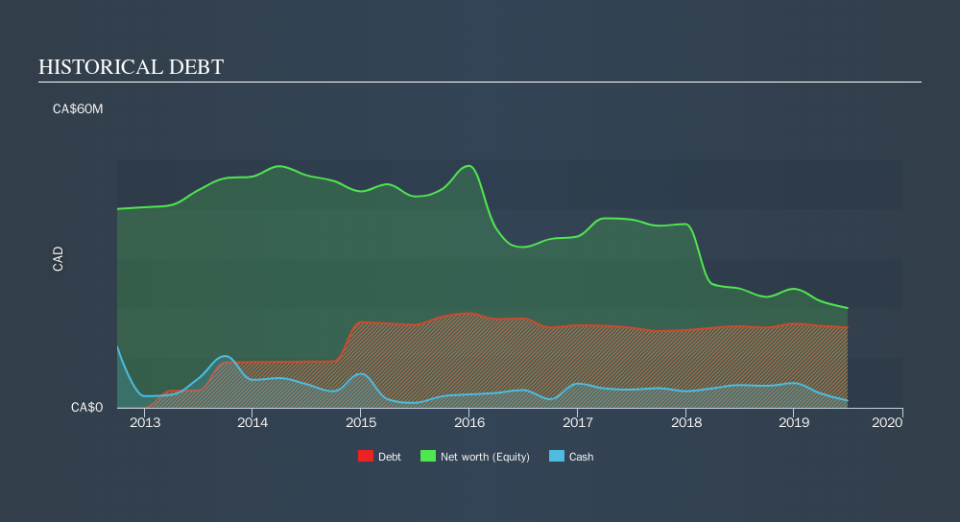Is Bengal Energy (TSE:BNG) A Risky Investment?

Legendary fund manager Li Lu (who Charlie Munger backed) once said, 'The biggest investment risk is not the volatility of prices, but whether you will suffer a permanent loss of capital. So it seems the smart money knows that debt - which is usually involved in bankruptcies - is a very important factor, when you assess how risky a company is. We can see that Bengal Energy Ltd. (TSE:BNG) does use debt in its business. But should shareholders be worried about its use of debt?
When Is Debt Dangerous?
Debt assists a business until the business has trouble paying it off, either with new capital or with free cash flow. Ultimately, if the company can't fulfill its legal obligations to repay debt, shareholders could walk away with nothing. However, a more usual (but still expensive) situation is where a company must dilute shareholders at a cheap share price simply to get debt under control. Of course, the upside of debt is that it often represents cheap capital, especially when it replaces dilution in a company with the ability to reinvest at high rates of return. When we think about a company's use of debt, we first look at cash and debt together.
View our latest analysis for Bengal Energy
What Is Bengal Energy's Debt?
As you can see below, Bengal Energy had CA$16.2m of debt, at June 2019, which is about the same the year before. You can click the chart for greater detail. However, it does have CA$1.47m in cash offsetting this, leading to net debt of about CA$14.7m.
How Healthy Is Bengal Energy's Balance Sheet?
The latest balance sheet data shows that Bengal Energy had liabilities of CA$18.2m due within a year, and liabilities of CA$2.12m falling due after that. Offsetting this, it had CA$1.47m in cash and CA$2.40m in receivables that were due within 12 months. So its liabilities total CA$16.4m more than the combination of its cash and short-term receivables.
This deficit casts a shadow over the CA$8.69m company, like a colossus towering over mere mortals. So we'd watch its balance sheet closely, without a doubt After all, Bengal Energy would likely require a major re-capitalisation if it had to pay its creditors today. When analysing debt levels, the balance sheet is the obvious place to start. But you can't view debt in total isolation; since Bengal Energy will need earnings to service that debt. So if you're keen to discover more about its earnings, it might be worth checking out this graph of its long term earnings trend.
In the last year Bengal Energy had negative earnings before interest and tax, and actually shrunk its revenue by 14%, to CA$9.4m. That's not what we would hope to see.
Caveat Emptor
While Bengal Energy's falling revenue is about as heartwarming as a wet blanket, arguably its earnings before interest and tax (EBIT) loss is even less appealing. Indeed, it lost a very considerable CA$877k at the EBIT level. Considering that alongside the liabilities mentioned above make us nervous about the company. We'd want to see some strong near-term improvements before getting too interested in the stock. Not least because it burned through CA$3.3m in negative free cash flow over the last year. That means it's on the risky side of things. For riskier companies like Bengal Energy I always like to keep an eye on whether insiders are buying or selling. So click here if you want to find out for yourself.
At the end of the day, it's often better to focus on companies that are free from net debt. You can access our special list of such companies (all with a track record of profit growth). It's free.
We aim to bring you long-term focused research analysis driven by fundamental data. Note that our analysis may not factor in the latest price-sensitive company announcements or qualitative material.
If you spot an error that warrants correction, please contact the editor at editorial-team@simplywallst.com. This article by Simply Wall St is general in nature. It does not constitute a recommendation to buy or sell any stock, and does not take account of your objectives, or your financial situation. Simply Wall St has no position in the stocks mentioned. Thank you for reading.

 Yahoo Finance
Yahoo Finance 
